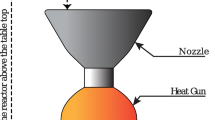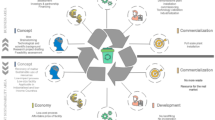Abstract
Hydrothermal carbonization (HTC) is a thermochemical conversion process with the potential to treat the prevalent wet urban biowaste in low- and middle-income countries. The generated hydrochar solids are a hygienic, homogenized, carbon rich and energy dense product with economic value that can be used as an alternative to wood-based charcoal or fossil fuel. Obtaining a satisfactory energy efficiency of the process is, however, one of the prerequisites for the possible breakthrough of this technology. In an experimental HTC reactor, a model kitchen/market waste feedstock (17.8 MJ/kgdb) was hydrothermally carbonized with varying loading rates (TS 20 and 25 %) under mild operational conditions with peak temperatures of 160–190 °C and process times of 2–10 h above 160 °C. The aim was to evaluate the energy ratio of the process under these conditions while examining the impact on the hydrochar quality. Results show that the chemical properties of the produced hydrochar and its heating value were of moderate quality (21.1–24.4 MJ/kgdb), showing similar characteristics like torrefied products. HTC of a 25 % TS-load during 2 h at 180 °C and maximum pressure of 18.3 bar resulted in a char chemical output energy that is twice as high as the electrical energy consumed in the process. If considering the theoretical methane potential of the process water, the energy ratio could be increased to 2.6; while reactor insulation could further enhance this ratio to 3. This article reveals the merits of mild HTC and provides relevant knowledge for attaining an optimized, energy efficient HTC system.










Similar content being viewed by others
References
Scheinberg, A., Wilson, D.C., Rodic, L.: Solid Waste Management in the World’s Cities. UN-Habitat’s Third Global Report on the State of Water and Sanitation in the World’s Cities. Earthscan for UN Habitat, London (2010)
Wilson, D.C., Rodic, L., Modak, P., Soos, R., Carpintero, A., Velis, C.A., Iyer, M., Simonett, O.: United Nations Environment Programme (UNEP) and International Solid Waste Association (ISWA). In: Wilson, D.C. (ed.) Global Waste Management Outlook. UNEP International Environment Technology Centre, Osaka (2015)
Guerrero, L.A., Maas, G., Hogland, W.: Solid waste management challenges for cities in developing countries. Waste Manag. 33(1), 220–232 (2012)
Hoornweg, D., Bhada-Tata, P.: What a Waste—A Global Review of Solid Waste Management. Urban Development & Local Government Unit, World Bank, Washington, DC (2012)
Wilson, D.C., Velis, C.A., Rodic L.: Integrated sustainable waste management in developing countries. Waste Manag. Res. 166(WR2), 52–68 (2013)
Wilson, D.C., Rodic, L., Scheinberg, A., Velis, C.A., Alabaster, G.: Comparative analysis of solid waste management in 20 cities. Waste Manag. Res. 30(3), 237–254 (2012)
Cointreau, S.J.: Occupational and Environmental Health Issues of Solid Waste Management—Special Emphasis on Middle- and Lower-Income Countries. The International Bank for Reconstruction and Development/The World Bank, Washington, DC (2006)
Manga, E.: Urban waste management in Cameroon: a new policy perspective? In: Diaz, L.F., Eggerth, L.L., Savage, G.M. (eds.) Management of Solid Waste in Developing Countries, pp. 95–104. Padova, CISA (2007)
Bogner, J., Pipattim, R., Hashimoto, S., Diaz, C., Mareckova, K., Diaz, L., Kjeldsen, P., Monni, S., Faaij, A., Gao, Q., Zhang, T., Ahmed, M.A., Sutamihardja, R.T.M., Gregory, R.: Mitigation of global greenhouse gas emissions from waste: conclusions and strategies from the Intergovernmental Panel on Climate Change (IPCC)—fourth assessment report. working group III (Mitigation). Waste Manag. Res. 26, 11–32 (2008)
Bleck, D., Wettberg, W.: Waste collection in developing countries—tackling occupational safety and health hazards at their source. Waste Manag. 32, 2009–2017 (2012)
Rothenberger, S., Zurbrügg, C., Enayetullah, I., Sinha, A.H.M.M.: Decentralised Composting for Cities of Low- and Middle-Income Countries—A User’s Manual. Sandec/Eawag and Waste Concern, Dhaka (2006)
Diener, S., Studt Solano, N.M., Zurbrügg, C., Tockner, K.: Biological treatment of municipal solid waste using black soldier fly larvae. Waste Biomass Valoriz. 2, 357–363 (2011)
Vögeli, Y., Lohri, C., Gallardo, A., Diener, S., Zurbrügg, C.: Anaerobic Digestion of Biowaste in Developing Countries. Practical Information and Case Studies. Eawag/Sandec publication, Dhaka (2014)
Lohri, C.R., Camenzind, E., Zurbrügg, C.: Financial sustainability of municipal solid waste management system—costs and revenues in Bahir Dar, Ethiopia. Waste Manag. 34, 542–552 (2014)
Lohri, C.R., Faraji, A., Ephata, E., Rajabu, H.M., Zurbrügg, C.: Urban biowaste for solid fuel production—waste suitability assessment and experimental carbonization in Dar es Salaam, Tanzania. Waste Manag. Res. 33(2), 175–182 (2015)
Bergius, F.: Die Anwendung hoher Drücke bei Chemischen Vorgängen und eine Nachbildung des Entstehungsprozesses der Steinkohle, pp. 33–58. Verlag Wilhelm Knapp, Halle an der Saale, Cologne (1913)
Titirici, M.-M., Arne, T., Antoniette, M.: Back in the black: hydrothermal carbonization of plant material as an efficient chemical process to treat the CO2 problem? New J. Chem. 31, 787–789 (2007)
Ramke, H.-G., Blöhse, D., Lehmann, H.-J., Fettig, J.: Hydrothermal carbonization of organic waste. Hydrothermal carbonization of organic waste. In: Cossu, R., Diaz, L.F., Stegmann, R. (eds.) 2009: Sardinia 2009: Twelfth International Waste Management and Landfill Symposium, Sardinia, Italy, 05–09 October 2009, Proceedings, CISA Publisher (2009)
Berge, N., Ro, K., Mao, J., Flora, J.R.V., Chappell, M., Bae, S.: Hydrothermal carbonization of municipal waste streams. Environ. Sci. Technol. 45, 5696–5703 (2011)
Basso, D., Castello, D., Baratieri, M., Fiori, L.: Hydrothermal carbonization of waste biomass: progress report and prospects. 21st European Biomass Conference and Exhibition, 3–7 June, Copenhagen, Denmark (2013)
Funke, A., Ziegler, F.: Hydrothermal carbonization of biomass: a summary and discussion of chemical mechanisms for process engineering. Biofuels Bioprod. Biorefin. 4, 160–177 (2010)
Lu, X., Jordan, B., Berge, N.D.: Thermal conversion of municipal solid waste via hydrothermal carbonization: comparison of carbonization products to products from current waste management techniques. Waste Manag. 32, 1353–1365 (2012)
Glasner, C., Deerberg, G., Lyko, H.: Hydrothermale Carbonisierung: Ein Überblick. Chem. Ing. Tech. 83(11), 1932–1943 (2011)
Lehmann, J., Joseph, S.: Biochar for Environmental Management-Science and Technology. Earthscan, London (2009)
Libra, J.A., Ro, K.S., Kammann, C., Funke, A., Berge, N.D., Neubauer, Y., Titirici, M.-M., Fühner, C., Bens, O., Kern, J., Emmerich, K.-H.: Hydrothermal carbonization of biomass residuals: a comparative review of the chemistry, processes and applications of wet and dry pyrolysis. Biofuels 2(1), 89–124 (2011)
Marchetti Dea, P.: Hydrothermal Carbonization (HTC) of Food Waste—Testing of a HTC Prototype Research Unit for Developing Countries. Universita’ degli studi di Pavia—Facolta’ di ingegneria in collaboration with Eawag/Sandec (2013)
Ruyter, H.P.: Coalification model. Fuel 61, 1182–1187 (1982)
Krause, A.: Hydrothermal carbonization as innovative technology in sustainable sanitation in Tanzania. Project carbonization as sanitation (CaSa). Technical University Berlin and Engineers without Borders Berlin, Germany. In: Schäfer, M., Kebir, N., Philipp, D. (eds.): Micro Perspectives for Decentralized Energy Supply. Proceedings of the International Conference, Technische Universität Berlin, 7th–8th of Apr 2011. Universitätsverlag der TU Berlin, Berlin (2011)
Robbiani, Z.: Hydrothermal carbonization of biowaste/faecal sludge. Conception and construction of a HTC prototype research unit for developing countries. Department of Mechanical Engineering ETHZ in collaboration with Eawag/Sandec (2013)
Peterson, A.A., Vogel, F., Lachance, R.P., Fröling, M., Antal, M.J., Tester, J.W.: Thermochemical biofuel production in hydrothermal media: a review of sub- and supercritical water technologies. Energy Environ. Sci. 1, 32–65 (2008)
Deutsche-Edelstahlwerke. 1.4307 Chromium-Nickel Austenitic Stainless Steel with Low Carbon Content. http://dew-stahl.com/fileadmin/files/dew-stahl.com/documents/Publikationen/Werkstoffdatenblaetter/RSH/Datenblatt_4307_UK_.pdf (2007). Accessed 17 Sept 2015
Outo-Kumpu. Standard Cr–Ni–Mo Stainless Steels. http://outokumpu.com/SiteCollectionDocuments/Standard_Cr-Ni-Mo_Stainless_Steels_Datasheet.pdf (2006). Accessed 17 Sept 2015
Stemann, J., Ziegler, F.: Assessment of the energetic efficiency of a continuously operating plant for hydrothermal carbonisation of biomass. World Renewable Energy Congress 2011, Sweden, pp. 125–132 (2011). doi:10.3384/ecp11057125
Antal, M.J., Allen, S.G., Dai, X., Shimizu, B., Tam, M.S., Grønli, M.G.: Attainment of the theoretical yield of carbon from biomass. Ind. Eng. Chem. Res. 39, 4024 (2000)
Danso-Boateng, E., Shama, G., Wheatley, A.D., Martin, S.J., Holdich, R.G.: Hydrothermal carbonisation of sewage sludge: effect of process conditions on product characteristics and methane production. Bioresour. Technol. 177, 318–327 (2015)
Funke, A.: Hydrothermale Verfahren (HTC, VTC) in der energetische Verwertungskette. In: Fricke et al., (eds.) Biokohle im Blick. Proceedings of Second INTERREG NSR Biochar Conference Berlin, 73. Symposium des ANS e.V., 2012, pp. 35–44 (2012)
Lu, L., Namioka, T., Yoshikawa, K.: Effects of hydrothermal treatment on characteristics and combustion behaviors of municipal solid wastes. Appl. Energy 88, 3659–3664 (2011)
FAO (Food and Agriculture Association). Using charcoal efficiently, chapter 10. In: Simple Technologies for Charcoal Making. Chapter 10—Using Charcoal Efficiently. First printed 1983, reprinted 1987. http://fao.org/docrep/x5328e/x5328e0b.htm. Accessed 19 Oct 2015
Antal, M.J., Grønli, M.: The art, science, and technology of charcoal production. Ind. Eng. Chem. Res. 42, 1619–1640 (2003)
Foley, G.: Charcoal Making in Developing Countries. Earthscan, London (1986)
Berge, N.D., Li, L., Flora, J.R.V., Ro, K.S.: Assessing the environmental impact of energy production form hydrochar generated viy hydrothermal carbonization of food wastes. Waste Manag. 43, 203–217 (2015)
Lynam, J.G., Reza, M.T., Vasquez, V.R., Coronella, C.J.: Effect of salt addition on hydrothermal carbonization of lignocellulosic biomass. Fuel 99, 271–273 (2012)
Kang, S., Li, X., Fan, J., Chang, J.: Characterization of hydrochars produced by hydrothermal carbonization of lignin, cellulose, d-xylose, and wood meal. Ind. Eng. Chem. Res. 51, 9023–9031 (2012)
Liu, Z., Balusubramanian, R.: Upgrading of waste biomass by hydrothermal carbonization (HTC) and low temperature pyrolysis (LTP): a comparative evaluation. Appl. Energy 114, 857–864 (2014)
Clingan, W.R.: Process for Production of Fuels and Chemicals from Biomass Feedstocks. http://google.com/patents/US20130232856 (2013). Accessed 14 Oct 2015
Mumme, J., Eckervogt, L., Pielert, J., Diakité, M., Rupp, F., Kern, J.: Hydrothermal carbonization of anaerobically digested maize silage. Bioresour. Technol. 102, 9255–9260 (2011)
Kleinschmidt, C.: Overview of International Developments in Torrefaction. http://ieabcc.nl/workshops/task32_2011_graz_torrefaction/Kleindschmidt_Paper.pdf (2011). Accessed 19 Oct 2015
Medic, D.: Investigation of torrefaction process parameters and characterization of torrefied biomass. Graduate Theses and Dissertations. Paper 12403. Iowa State University (2012)
Acknowledgments
The authors wish to acknowledge Zeno Robbiani and Paola Dea Marchetti for their preliminary work on HTC at Eawag/Sandec. Many thanks to the Zurich University of Applied Sciences (ZHAW; Dr. Rolf Krebs, Andreas Schönborn, Gabriel Gerner, Alexander Treichler, Rahel Wanner), and the Paul Scherrer Instiute (PSI; Timon Käser) for their technical support. The financial support of the Swiss Agency for Development and Cooperation (SDC) is gratefully recognized.
Author information
Authors and Affiliations
Corresponding author
Rights and permissions
About this article
Cite this article
Lohri, C.R., Zabaleta, I., Rohr, M. et al. Improving the Energy-Related Aspects of Biowaste Treatment in an Experimental Hydrothermal Carbonization Reactor. Waste Biomass Valor 9, 429–442 (2018). https://doi.org/10.1007/s12649-016-9746-3
Received:
Accepted:
Published:
Issue Date:
DOI: https://doi.org/10.1007/s12649-016-9746-3




